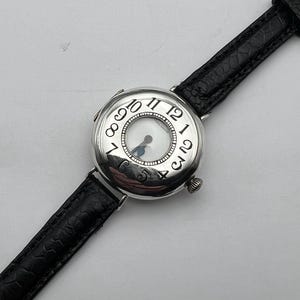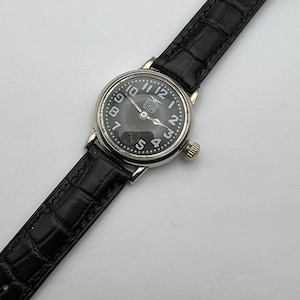

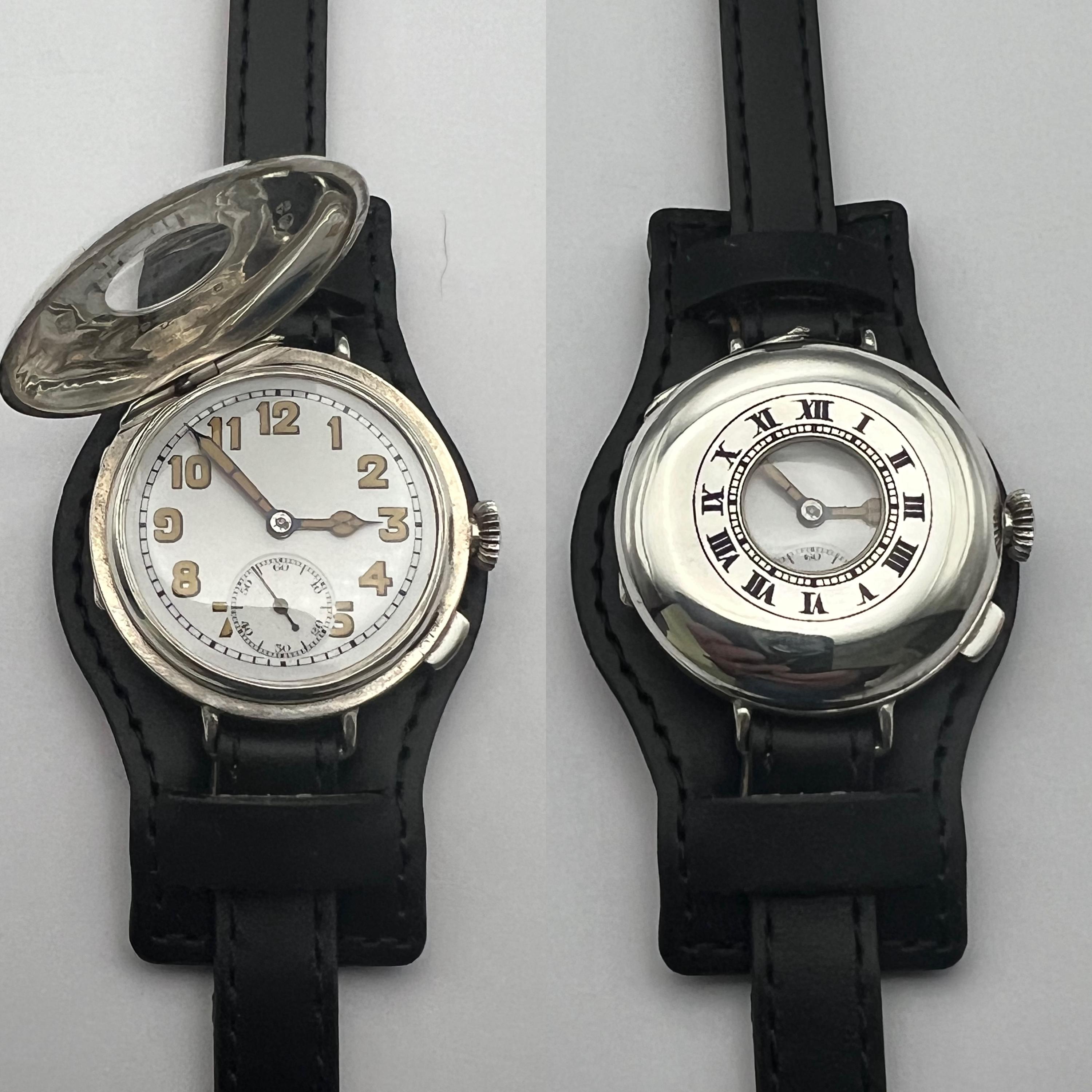
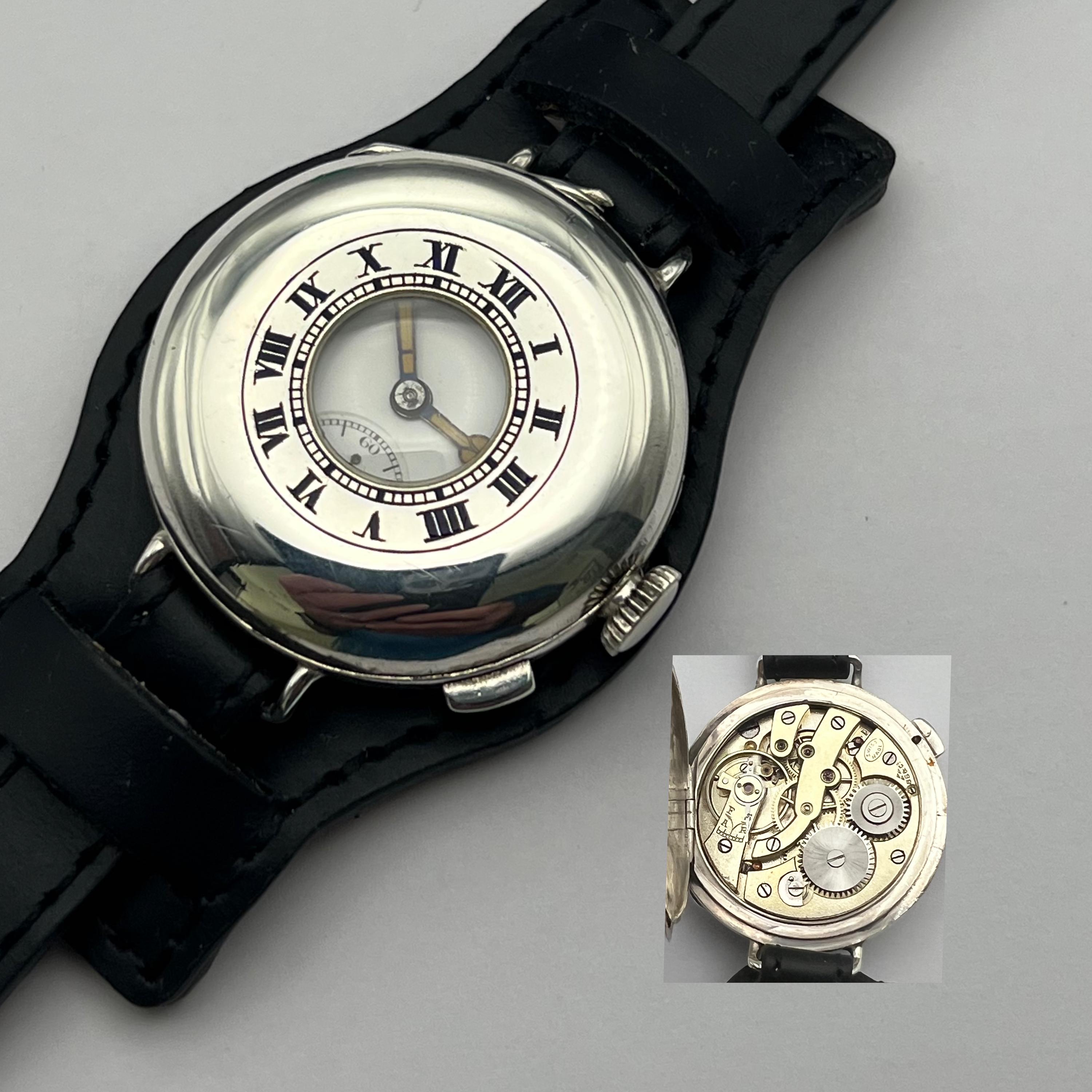




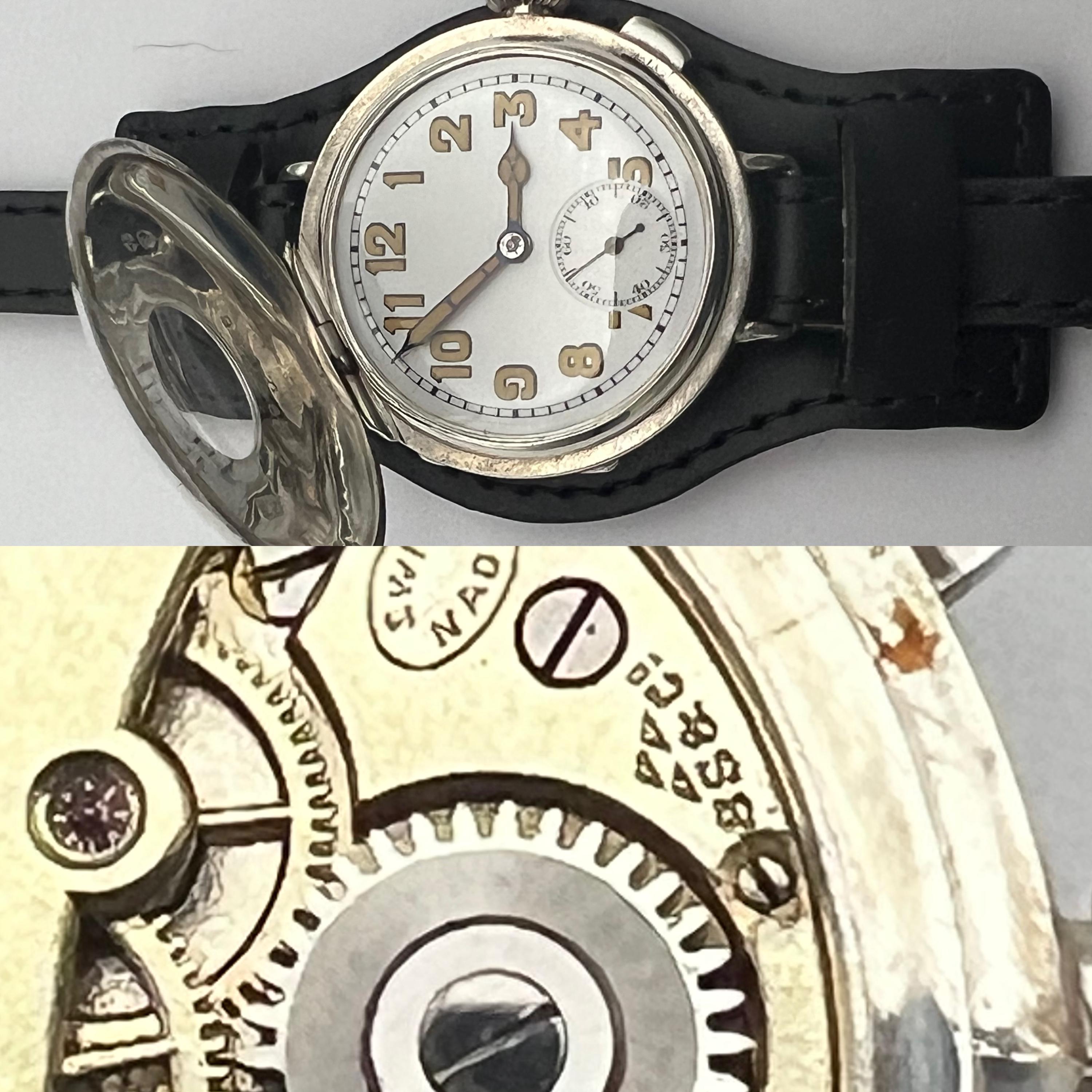

1915 SS&Co, Sterling Silver Half Hunter Trench Watch 15 Jewels
$1,371.00
(1)
-
DetailsI am listing this as it is getting adjusted.(November 8th 2025) it will be available to ship the first week of December 2025)
From my small vintage corner filled with American watches from the 1880s to the 1930s, this remarkable survivor tells a different story—one born in London and tied to the earliest days of the wristwatch.
This sterling silver Stauffer, Son & Co. timepiece is a rare 1915 British–Swiss hybrid, a true artifact from the WWI wristwatch era—the period when the “wristlet,” as soldiers first called it, became an essential tool of the modern world.
Historical Provenance
The hallmark tells us much about this watch’s era. A small lowercase “q” struck inside the case confirms the 1915 Birmingham assay date, marking it as an authentic piece of the First World War period. The case also bears the sponsor’s stamp “C.N.” for Charles Nicolet—Stauffer’s registered London sponsor. Although sometimes misattributed as the maker, Nicolet’s mark signifies that the case was imported and submitted for assay by Stauffer & Co., who held one of the largest and most respected Swiss watch import businesses in Britain.
The connection to Stauffer, Son & Co. (SS&Co) situates this watch firmly within the fabric of early Swiss horology. SS&Co operated the famed La Chaux-de-Fonds “Atlas” factory and imported watches from Patek Philippe, LeCoultre, IWC, and Fontainemelon. Their hallmark—three small triangles surmounting SS&Co—is stamped proudly on the movement.
Technical and Cosmetic Details
• Case: Solid sterling silver, 34mm (without crown), Glasgow origin stamp
• Movement: High-grade Swiss 15 jewel SS&Co. mechanism, recently serviced (May 2025)
• Case Design: Rare half-hunter style with spring lid and enamel numerals on bezel
• Dial: Original enamel dial and gilt cathedral hands, restored with safe luminous material
• Crown: Original, matching period-correct form
• Crystal: New replacement
• Stem: Replaced with correct modern counterpart
• Case Finish: Hand polished, retaining historic character
This is not merely a timepiece—it is the story of how the wristwatch came to be. Before the wristwatch became mainstream, a customer would visit a jeweler and select each component individually: the case material, an enamel dial, hands, and a movement from renowned houses like Stauffer & Co., Rolex, Omega, or Elgin. The jeweler would then assemble a bespoke instrument that reflected both style and function. This example, with its SS&Co import and half-hunter case, represents one of the finest results of that early tradition.
Condition and Character
Recently serviced and running beautifully, the watch has been gently revived—never erased. Its enamel bezel numerals remain vivid, the dial radiates quiet authenticity, and every tick reminds us of its century-long journey. Few trench watches have survived in such harmony, preserving both mechanical health and original details.
Why It Matters
This 1915 Stauffer half-hunter bridges the end of the pocket watch era and the birth of the modern wristwatch. It carries with it the pride of Swiss manufacturing, British craftsmanship, and wartime practicality—all encased in silver and history.
For the historian, collector, or sentimentalist—this is a signature heirloom from the moment the world’s soldiers first strapped time to their wrists.
Stauffer, Son & Co. (SS&Co) occupies a significant place in horological history, especially for its role in connecting high-grade Swiss watchmaking with the British market during a transformative era for wristwatches.[vintagewatchstraps]
Origins and Growth
Founded in Geneva and La Chaux-de-Fonds in 1830 by Charles Philip Stauffer and his son Julius, SS&Co quickly established a reputation for fine watchmaking. Julius opened a London office to import watches from their Swiss factory, swiftly growing it into one of Britain’s largest watch importers. By the 1880s, the company exported not only their own watches but also pieces from prestigious makers like Patek Philippe, Le Coultre, IWC, Eterna, and Fontainemelon.[antiques-atlas +1]
The Atlas Factory and Swiss Quality
SS&Co’s “Atlas” factory in La Chaux-de-Fonds became a hub of quality and innovation. By 1885, it was producing as many as 60,000 watches annually, but demand still outstripped supply, prompting SS&Co to also wholesale watches from other manufacturers. Their own highest-grade movements were distinguished by the SS&Co mark beneath three triangles—a hallmark for collectors denoting their best work.[vintagewatchspecialist +2]
Bridge to the Modern Wristwatch
SS&Co was at the heart of the wristwatch’s rise, especially in Britain. Their movements and cases—often bearing British hallmarks and sponsor’s marks—helped define what a practical, durable, and stylish wristlet (early wristwatch) could be. They ensured high Swiss standards were available to English jewelers and consumers while navigating British legal requirements, such as the Merchandise Marks Act of 1887 and hallmarking laws after 1907.[timewornwatches +2]
Partnerships and Influence
SS&Co imported and co-branded watches from IWC starting in 1894, becoming IWC’s principal distributor in Britain and sometimes even having sales monopoly rights. Their influence meant that even movements from outside factories (Fontainemelon, Eterna, etc.) would bear SS&Co branding—sometimes causing modern confusion over origins but ensuring that customers received quality, reliable timepieces carrying the SS&Co reputation.[vintagewatchstraps +2]
Legacy
Under the direction of Charles Nicolet, SS&Co became a leading supplier of chronographs for sporting events, including the Gordon Bennet Cup car races. The company’s reach and quality control made it one of the most trusted names in British horology, helping to bridge Swiss technical mastery with British retail traditions through a period of immense societal and technological change.[vintagewatchstraps +1]
SS&Co’s story is woven into the fabric of early wristwatch history—its marks signifying more than just manufacture, but an era of innovation, international collaboration, and timeless style for collectors today.[antiques-atlas +2]
What is the direct connection to IWC
Stauffer, Son & Co. (SS&Co) became the official British agent and importer for IWC (International Watch Company) starting in approximately 1894–1895, a relationship they maintained until the mid-1930s. During this period, IWC produced watches specifically for SS&Co’s London operation, which were then branded with Stauffer trademarks such as “S&Co” and “Peerless” instead of IWC’s own name.[vintagewatchstraps +4]
The watches themselves were manufactured by IWC in Schaffhausen but were supplied to Stauffer for retail and distribution in Britain. While the IWC name was generally not visible on the outside, the movements of these watches were subtly marked with an IWC trademark under the dial or bottom plate. This strong partnership allowed IWC to penetrate the UK market through the established network and reputation of SS&Co, which was Britain’s largest importer of fine Swiss watches at the time.[vintagewatchstraps +1]
As a result of this connection, SS&Co-branded watches from the era may contain IWC movements and heritage, though it’s important not to assume every watch with Stauffer markings is of IWC origin, as SS&Co also sourced from other high-grade Swiss manufacturers. Still, the partnership is historically significant for introducing IWC’s technical excellence and watchmaking standards to British consumers, helping cement IWC’s reputation in the UK luxury watch market throughout the early 20th century. -
Shipping & Policies
Shipping from United States
Processing time
1-5 business days
Customs and import taxes
Buyers are responsible for any customs and import taxes that may apply. I'm not responsible for delays due to customs.
Payment Options
Returns & Exchanges
I gladly accept returns, exchanges, and cancellations
Just contact me within: 14 days of delivery
Ship items back to me within: 30 days of delivery
- Custom or personalized orders
- Perishable products (like food or flowers)
- Digital downloads
- Intimate items (for health/hygiene reasons)
- Items on sale
Conditions of return
Buyers are responsible for return shipping costs. If the item is not returned in its original condition, the buyer is responsible for any loss in value.
Questions about your order?
Please contact me if you have any problems with your order.
Frequently Asked Questions
Custom and personalized orders
I will review your requests and evaluate it for completion
-
Reviews
Reviews (1)
Average:



